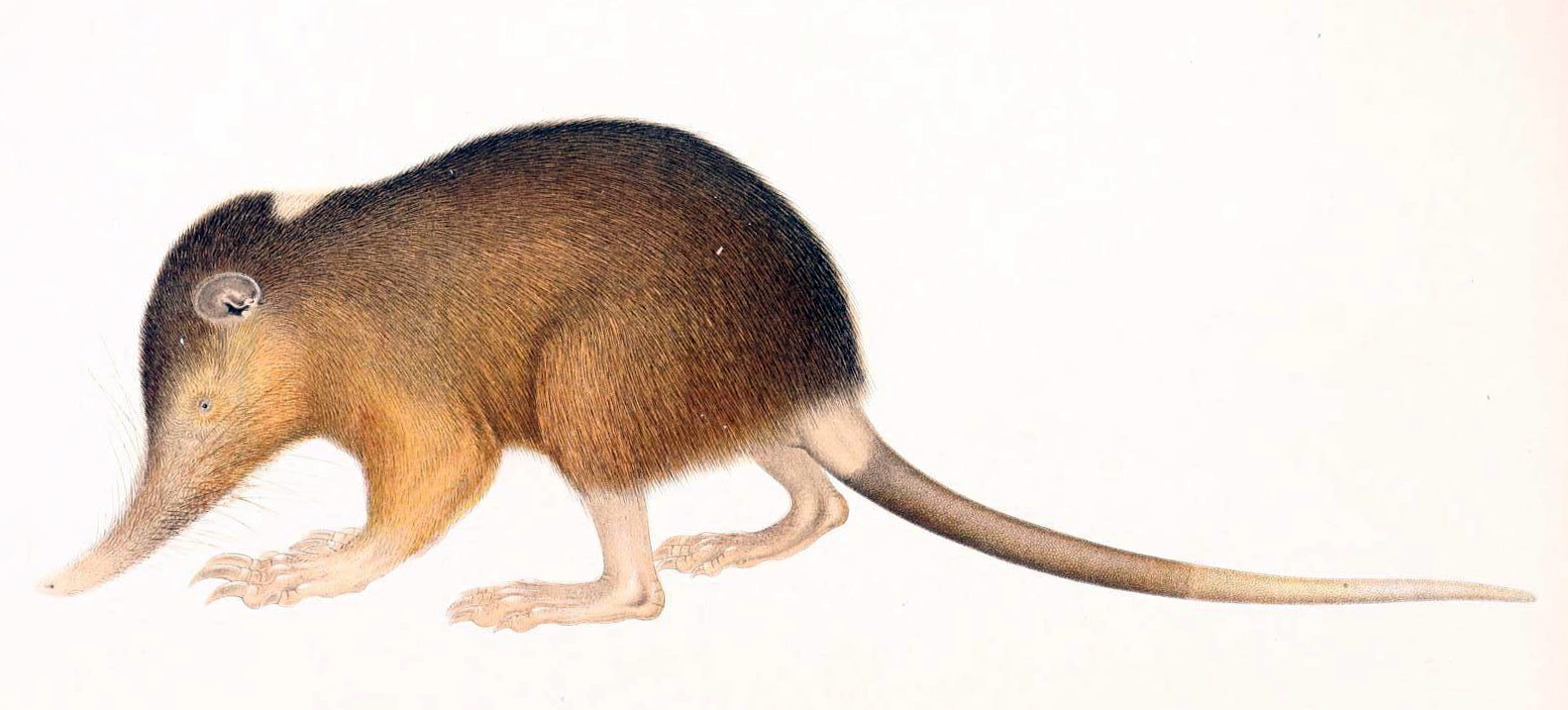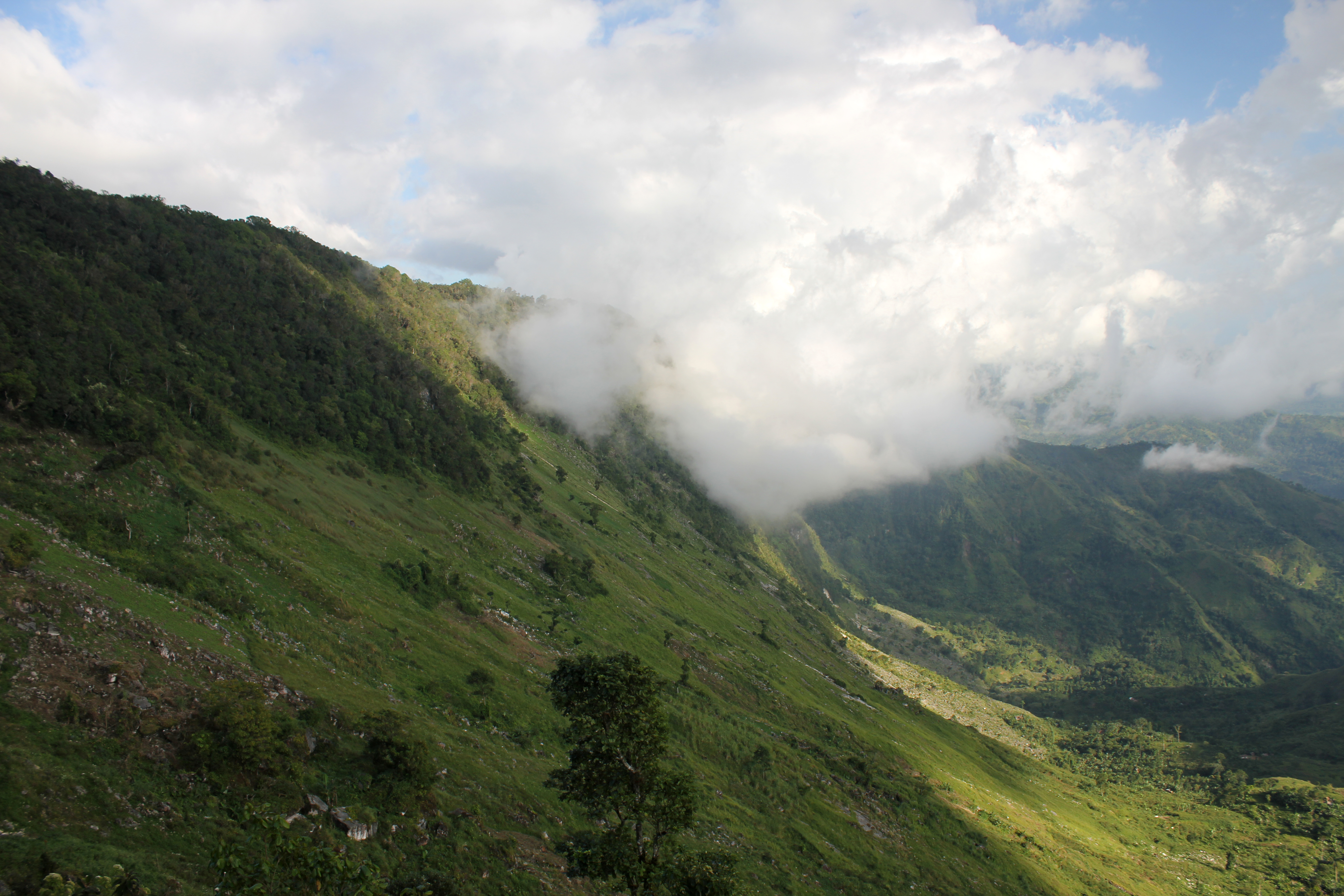|
Hispaniolan Solenodon
The Hispaniolan solenodon (''Solenodon paradoxus'') is a small, furry, shrew-like mammal endemic to the Caribbean island of Hispaniola (in the Dominican Republic and Haiti). Like other solenodons, it is a venomous, insect-eating animal that lives in burrows and is active at night. It is an elusive animal and was only first described in 1833; its numbers are stable in protected forests but it remains the focus of conservation efforts. Its smaller sister species of the same genus, Marcano's solenodon (''S. marconoi'') became extinct after European colonization. The Hispaniolan solenodon and the rat-like Hispaniolan hutia live in the same habitats and are the only surviving mammals native to the island. Discovery In 1833 the Russian Academy of Sciences received a new specimen from Haiti. Puzzled by the animal, curator Johann Friedrich von Brandt named it ''Solenodon paradoxus''. (''Solenodon'' means "grooved teeth".) No more information was known other than a relation to the Cuban ... [...More Info...] [...Related Items...] OR: [Wikipedia] [Google] [Baidu] |
Johann Friedrich Von Brandt
Johann Friedrich von Brandt (25 May 1802 – 15 July 1879) was a German-Russian natural history, naturalist, who worked mostly in Russia. Brandt was born in Jüterbog and educated at a Gymnasium (school), gymnasium in Wittenberg and the Humboldt University of Berlin, University of Berlin. In 1831 he emigrated to Russia, and soon was appointed director of the Zoological Museum of the St Petersburg Academy of Sciences. Brandt encouraged the collection of native animals, many of which were not represented in the museum. Many specimens began to arrive from the expeditions of Nikolai Alekseevich Severtzov, Severtzov, Nikolai Przhevalsky, Przhevalsky, Aleksandr Fyodorovich Middendorf, Middendorff, Leopold von Schrenck, Schrenck and Gustav Radde. He described several birds collected by Russian explorers off the Pacific Coast of North America, including Brandt's cormorant, red-legged kittiwake and spectacled eider. As a paleontologist, Brandt ranks among the best. He was also an entomo ... [...More Info...] [...Related Items...] OR: [Wikipedia] [Google] [Baidu] |
Dental Formula
Dentition pertains to the development of teeth and their arrangement in the mouth. In particular, it is the characteristic arrangement, kind, and number of teeth in a given species at a given age. That is, the number, type, and morpho-physiology (that is, the relationship between the shape and form of the tooth in question and its inferred function) of the teeth of an animal. Animals whose teeth are all of the same type, such as most non-mammalian vertebrates, are said to have '' homodont'' dentition, whereas those whose teeth differ morphologically are said to have '' heterodont'' dentition. The dentition of animals with two successions of teeth (deciduous, permanent) is referred to as '' diphyodont'', while the dentition of animals with only one set of teeth throughout life is ''monophyodont''. The dentition of animals in which the teeth are continuously discarded and replaced throughout life is termed ''polyphyodont''. The dentition of animals in which the teeth are set in s ... [...More Info...] [...Related Items...] OR: [Wikipedia] [Google] [Baidu] |
Teat
A teat is the projection from the mammary glands of mammals from which milk flows or is ejected for the purpose of feeding young. In many mammals the teat projects from the udder. The number of teats varies by mammalian species and often corresponds to the average litter size for that animal. In some cases, the teats of female animals are milked for the purpose of human consumption. The quality of some domesticated animals is determined by the establishment of desired characteristics, such as teat size and placement. Number and positioning in animals The number and positioning of mammary glands and teats varies widely among mammals. The protruding teats and accompanying glands can be located anywhere along the two milk lines. In general most mammals develop mammary glands in pairs along these lines, with a number approximating the number of young typically birthed at a time. The number of teats varies from 2 (in elephants and anthropoids) to 18 (in pigs). Marsupials usually h ... [...More Info...] [...Related Items...] OR: [Wikipedia] [Google] [Baidu] |
Litter (animal)
A litter is the live birth of multiple offspring at one time in animals from the same mother and usually from one set of parents, particularly from three to eight offspring. The word is most often used for the offspring of mammals, but can be used for any animal that gives birth to multiple young. In comparison, a group of eggs and the offspring that hatch from them are frequently called a clutch, while young birds are often called a brood. Animals from the same litter are referred to as litter-mates. Litter A species' average litter size is generally equal to one half of the number of teats and the maximum litter size generally matches the number of teats. Not all species abide by this rule, however. The naked mole rat, for example, averages roughly eleven young per birth and has eleven teats. Animals frequently display grouping behavior in herds, swarms, flocks, or colonies, and these multiple births derive similar advantages. A litter offers some protection from predation, not ... [...More Info...] [...Related Items...] OR: [Wikipedia] [Google] [Baidu] |
Biosonar
Echolocation, also called bio sonar, is a biological sonar used by several animal species. Echolocating animals emit calls out to the environment and listen to the echoes of those calls that return from various objects near them. They use these echoes to locate and identify the objects. Echolocation is used for navigation, foraging, and hunting in various environments. Echolocating animals include some mammals (most notably Laurasiatheria) and a few birds, especially some bat species and odontocetes (toothed whales and dolphins), but also in simpler forms in other groups such as shrews, and two cave-dwelling bird groups, the so-called cave swiftlets in the genus ''Aerodramus'' (formerly ''Collocalia'') and the unrelated oilbird ''Steatornis caripensis''. Early research The term ''echolocation'' was coined in 1938 by the American zoologist Donald Griffin, who, with Robert Galambos, first demonstrated the phenomenon in bats. As Griffin described in his book, the 18th century I ... [...More Info...] [...Related Items...] OR: [Wikipedia] [Google] [Baidu] |
Arthropod
Arthropods (, (gen. ποδός)) are invertebrate animals with an exoskeleton, a Segmentation (biology), segmented body, and paired jointed appendages. Arthropods form the phylum Arthropoda. They are distinguished by their jointed limbs and Arthropod cuticle, cuticle made of chitin, often Mineralization (biology), mineralised with calcium carbonate. The arthropod body plan consists of segments, each with a pair of appendages. Arthropods are bilaterally symmetrical and their body possesses an exoskeleton, external skeleton. In order to keep growing, they must go through stages of moulting, a process by which they shed their exoskeleton to reveal a new one. Some species have wings. They are an extremely diverse group, with up to 10 million species. The haemocoel, an arthropod's internal cavity, through which its haemolymph – analogue of blood – circulates, accommodates its interior Organ (anatomy), organs; it has an open circulatory system. Like their exteriors, the internal or ... [...More Info...] [...Related Items...] OR: [Wikipedia] [Google] [Baidu] |
Burrow
An Eastern chipmunk at the entrance of its burrow A burrow is a hole or tunnel excavated into the ground by an animal to construct a space suitable for habitation or temporary refuge, or as a byproduct of locomotion. Burrows provide a form of shelter against predation and exposure to the elements, and can be found in nearly every biome and among various biological interactions. Many animal species are known to form burrows. These species range from small invertebrates, such as the ''Corophium arenarium'', to very large vertebrate species such as the polar bear. Burrows can be constructed into a wide variety of substrates and can range in complexity from a simple tube a few centimeters long to a complex network of interconnecting tunnels and chambers hundreds or thousands of meters in total length; an example of the latter level of complexity, a well-developed burrow, would be a rabbit warren. Vertebrate burrows A large variety of vertebrates construct or use burrows in many t ... [...More Info...] [...Related Items...] OR: [Wikipedia] [Google] [Baidu] |
Los Haitises National Park
Los Haitises National Park is a national park located on the remote northeast coast of the Dominican Republic that was established in 1976. It consists of a limestone karst plateau with conical hills, sinkholes and caverns, and there is a large area of mangrove forest on the coast. Other parts of the park are clad in subtropical humid forest and the area has an annual precipitation of about . The park contains a number of different habitats and consequently has a great diversity of mammals and birds, including some rare species endemic to the island. Some of the caverns contain pictograms and petroglyphs. The park has become a popular ecotourism destination but the number of tourists allowed to visit is limited. History The park was created by Law 409 enacted June 3, 1976. It was preceded by a Reserva Forestal (Forest Reserve) called Zona Vedada de Los Haitises (Los Haitises Prohibited Zone), created by Law 244. In 1996, its area was expanded from by Decree 233. Its boundary, whic ... [...More Info...] [...Related Items...] OR: [Wikipedia] [Google] [Baidu] |
Massif De La Hotte
The Massif de la Hotte is a mountain range in southwestern Haiti, on the Tiburon Peninsula. About 2.5 million years ago, Massif de la Hotte was separated from the Massif de la Selle by a deep, wide sea channel, and formed a separate island. This resulted in a hotbed of endemism in la Hottes bird, plant, and reptile communities. The Massif de la Hotte is subdivided into the Oriental la Hotte in the East, the central la Hotte and the Occidental la Hotte on the Western tip of the Tiburon peninsula. The Occidental la Hotte is relatively remote and is one of the most biologically diverse and significant areas of all of Hispaniola. It also supports some of the last stands of Haiti's dense cloud forest on its peaks. Haiti has a World Heritage Site located here. In the wake of the 2010 Haiti earthquake, UNESCO's World Heritage Program is helping Haiti assess the damage. Biodiversity and conservation Occidental la Hottes is the highest and biologically most diverse part of Massif de la H ... [...More Info...] [...Related Items...] OR: [Wikipedia] [Google] [Baidu] |
La Visite National Park
La Visite National Park (french: Parc National La Visite) is one of the two largest national parks of the Republic of Haiti. La Visite is a part of the Massif de la Selle mountain range. Its highest peak is 2275 meters in elevation. The park covers approximately 11,419 hectares of land with 1897 hectares above 2000 meters in elevation, and consists mainly of pine forest, grasslands, and some montane broadleaf forest at an altitude above . The Haitian government established the La Visite National Park in 1983. The capital, Port-au-Prince, is only 22 kilometers north from the park. The northern boundary of La Visite National Park is the east-west running escarpment of the Massif de la Selle. Vegetation The park's vegetation is broadleaf forest, grasslands and pine trees. The Hispaniolan Pine (''Pinus occidentalis'') is the most widespread tree in the park. Other type of forests that cover the park include karst broadleaf and wet broadleaf montane. Avifauna The park offers excel ... [...More Info...] [...Related Items...] OR: [Wikipedia] [Google] [Baidu] |
Jaragua National Park
Jaragua National Park ( es, Parque Nacional Jaragua) is a national park of the Dominican Republic. Jaragua National Park is located in the Pedernales Province in the extreme southwest of the Dominican Republic. Jaragua National Park has a total area of 1374 km² (905 km² of which are marine), making it the largest protected area in the Caribbean region. Geography Jaragua National Park was established by Presidential Decree No. 1315 on August 11, 1983, and was named after the Taíno Chiefdom of Xaragua. The park is represented by the Hispaniolan dry forests ecoregion. Spanning the southern slopes of the Baoruco Mountain Range from Oviedo to Cabo Rojo, Jaragua National Park includes dry forest, mangroves, and scrub, as well as land and marine habitats. Beata Island (''Isla Beata''), Alto Velo Island, Bahia de las Aguilas and Lago de Oviedo (noted for its diverse bird life) are part of the park. Among the variety of habitats found in Jaragua, numerous lagoons are located with ... [...More Info...] [...Related Items...] OR: [Wikipedia] [Google] [Baidu] |
Tiburon Peninsula (Haiti)
The Tiburon Peninsula (french: Péninsule de Tiburon), or The Xaragua Peninsula, simply "the Tiburon" (''le Tiburon''), is a region of Haiti encompassing most of Haiti's southern coast. It starts roughly at the southernmost point of the Haiti-Dominican Republic border and extends westward near Cuba, forming a large headland. Three of Haiti's ten departments are located entirely within the region. They are the departments of Grand'Anse, Nippes and Sud. Etymology The wordTiburonand Xaragua are linked to the Taino natives who were the region's first inhabitants. The region is often referred to as the Great South, le Grand-Sud (french), or Nansid (Haitian). Administrative Division The Tiburon is 1 of the 4 regions of Haiti, administrated through 4 departments and 1 arrondissement. Half of Sud-Est is also located within the Tiburon Peninsula. A large part of Ouest department is also located in the region, with the capital, Port-au-Prince serving as the line of demarcation betwe ... [...More Info...] [...Related Items...] OR: [Wikipedia] [Google] [Baidu] |







